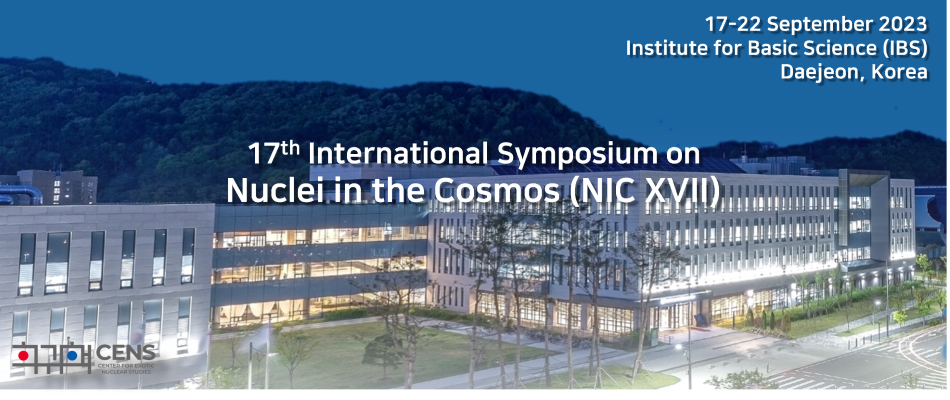Speaker
Description
Triple-$\alpha$ reaction plays a significant role in nucleosynthesis heavier than $^{12}$C and concomitant stellar evolution [1]. The reaction rates of this reaction at the helium-burning temperatures, $T_9 > 0.1$, are dominated by the sequential process via two narrow resonances: $\alpha+\alpha\rightarrow ^8$Be(0$^+_1$), $^8$Be+$\alpha \rightarrow ^{12}$C(0$^+_2$: $E=0.379$ MeV) [2,3], and they have been thought to decide a fate of massive stars up to their supernova explosion. $T_9$ is temperature in the unit of 10$^9$ K; $E$ is the center-of-mass energy to the 3$\alpha$ threshold in $^{12}$C.
In NACRE [2], $^8$Be is assumed to be bound as a particle, and the reaction rates have been estimated by an improved model with the sequential process based on [4,5]. To determine the rates more accurately, the precise experimental decay studies of the 0$^+_2$ resonance have been performed recently (e.g. [6]). The theoretical models have also been being developed during decades. To take account of 3$\alpha$ continuum states distorted by the long-range Coulomb interaction, the methods with hyper-spherical coordinates are used in [7-10], and the Coulomb modified Faddeev method is also adopted in [11]. Whereas $^8$Be continuum states are treated adiabatically in Refs. [9-11], the direct process from ternary continuum states, $\alpha+\alpha+\alpha \rightarrow ^{12}$C, is calculated non-adiabatically in Refs. [7,8]. Although the theoretical models are consistent with each other at the helium-burning temperatures, they make the large difference in the rates below $T_9 = 0.07$. From the comparison between the calculations, Ref. [7] has found that the current reaction rates at $T_9 = 0.05$ can be reduced by about 10$^{-4}$, because of the assumed $^8$Be.
In this presentation, I review the non-adiabatic approach to the triple-$\alpha$ reaction, and provide the derived rates. I use the Faddeev hyper-spherical harmonics and $R$-matrix (HHR$^\ast$) expansion method [7,12,13], and I confirm that the photo-disintegration of $^{12}$C(2$^+_1$($E=-2.835$ MeV) $\rightarrow$ 0$^+$) for $0.15 < E < 0.35$ MeV is 10$^{-15}$ -- 10$^{-3}$ pb order of cross sections. The resultant rates are shown to have the strong temperature dependence below $T_9 = 0.1$, as well as NACRE, and their numerical values are expressed in a simple analytic form [2,14].
[1] F. Hoyle, Astrophys. J. Suppl. Ser. 1, 121 (1954); E.E. Salpeter, Astrophys. J. 115, 326 (1952).
[2] C. Angulo, M. Arnould, M. Rayet, et al., Nucl. Phys. A 656, 3 (1999).
[3] G.R. Caughlan, W.A. Fowler, At. Data Nucl. Data Tables 40, 283 (1988).
[4] K. Nomoto, F.-K. Thielemann, S. Miyaji, Astron. Astrophys. 149, 239 (1985).
[5] K. Langanke, M. Wiescher, F.-K. Thielemann, Z. Phys. A 324, 147 (1986).
[6] D. Dell'Aquila, et al., PRL 119, 132501 (2017); R. Smith, et al., PRL 119, 132502 (2017).
[7] M. Katsuma, to appear in Proc. OMEG16, Communications in Physics, arXiv:2302.03844 (2023).
[8] N.B. Nguyen, F.M. Nunes, I.J. Thompson, PRC 87, 054615 (2013); N.B. Nguyen, F.M. Nunes, I.J. Thompson, E.F. Brown, PRL 109, 141101 (2012).
[9] D.V. Fedorov, A.S. Jensen, PLB 389, 631 (1996).
[10] H. Suno, Y. Suzuki, P. Descouvemont, PRC 94, 054607 (2016).
[11] S. Ishikawa, PRC 87, 055804 (2013); ibid. 90, 061604 (2014).
[12] I.J. Thompson, F.M. Nunes, Nuclear Reactions for Astrophysics, (Cambridge Univ. Press, 2009).
[13] P. Descouvemont, J. Phys. G 37, 64010 (2010); Theoretical Models for Nuclear Astrophysics, (Nova Science Publishers, 2003).
[14] JINA Reaclib, https://reaclib.jinaweb.org

